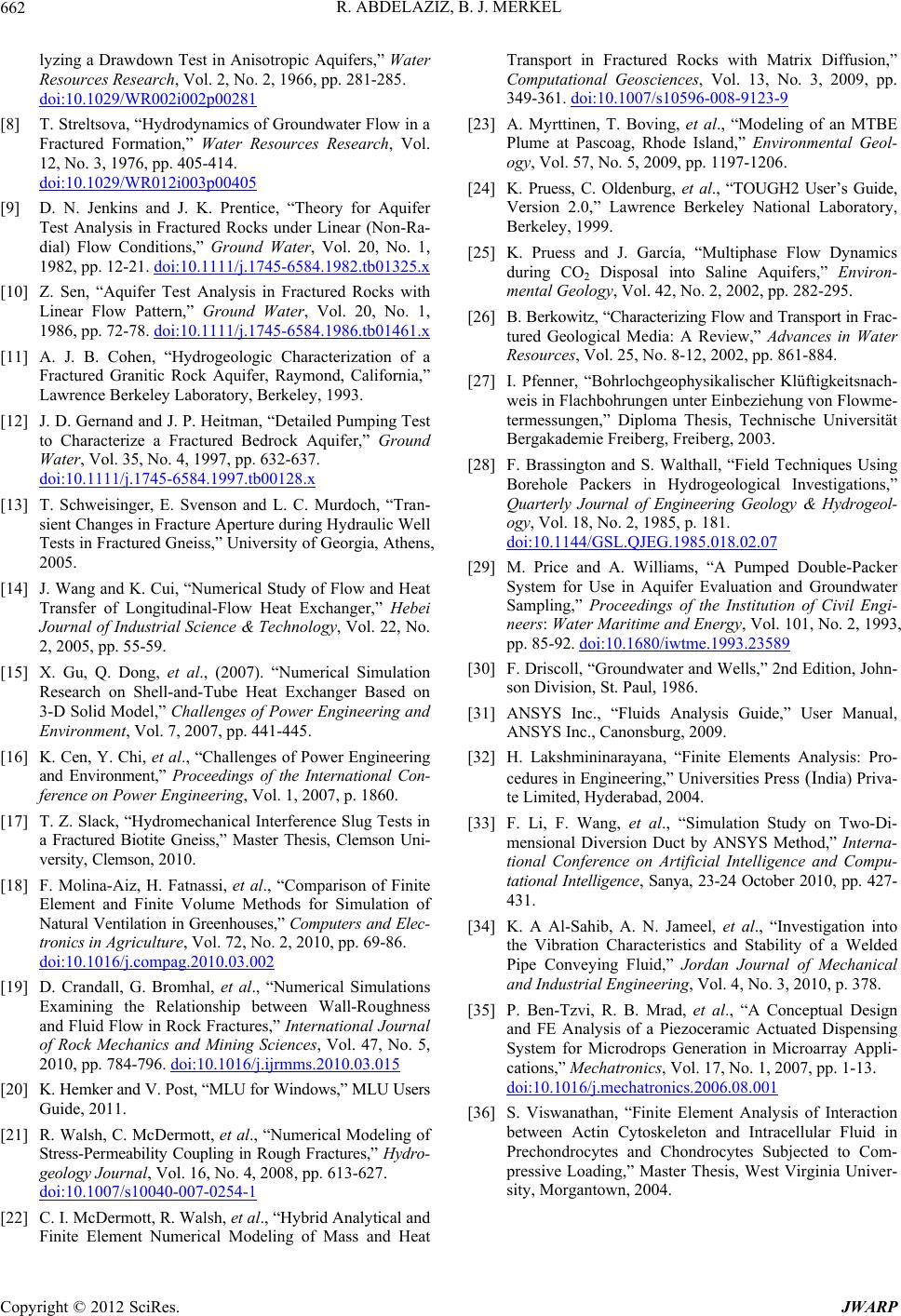
R. ABDELAZIZ, B. J. MERKEL
Copyright © 2012 SciRes. JWARP
662
lyzing a Drawdown Test in Anisotropic Aquifers,” Water
Resources Research, Vol. 2, No. 2, 1966, pp. 281-285.
doi:10.1029/WR002i002p00281
[8] T. Streltsova, “Hydrodynamics of Groundwater Flow in a
Fractured Formation,” Water Resources Research, Vol.
12, No. 3, 1976, pp. 405-414.
doi:10.1029/WR012i003p00405
[9] D. N. Jenkins and J. K. Prentice, “Theory for Aquifer
Test Analysis in Fractured Rocks under Linear (Non-Ra-
dial) Flow Conditions,” Ground Water, Vol. 20, No. 1,
1982, pp. 12-21. doi:10.1111/j.1745-6584.1982.tb01325.x
[10] Z. Sen, “Aquifer Test Analysis in Fractured Rocks with
Linear Flow Pattern,” Ground Water, Vol. 20, No. 1,
1986, pp. 72-78. doi:10.1111/j.1745-6584.1986.tb01461.x
[11] A. J. B. Cohen, “Hydrogeologic Characterization of a
Fractured Granitic Rock Aquifer, Raymond, California,”
Lawrence Berkeley Laboratory, Berkeley, 1993.
[12] J. D. Gernand and J. P. Heitman, “Detailed Pumping Test
to Characterize a Fractured Bedrock Aquifer,” Ground
Water, Vol. 35, No. 4, 1997, pp. 632-637.
doi:10.1111/j.1745-6584.1997.tb00128.x
[13] T. Schweisinger, E. Svenson and L. C. Murdoch, “Tran-
sient Changes in Fracture Aperture during Hydraulic Well
Tests in Fractured Gneiss,” University of Georgia, Athens,
2005.
[14] J. Wang and K. Cui, “Numerical Study of Flow and Heat
Transfer of Longitudinal-Flow Heat Exchanger,” Hebei
Journal of Industrial Science & Technology, Vol. 22, No.
2, 2005, pp. 55-59.
[15] X. Gu, Q. Dong, et al., (2007). “Numerical Simulation
Research on Shell-and-Tube Heat Exchanger Based on
3-D Solid Model,” Challenges of Power Engineering and
Environment, Vol. 7, 2007, pp. 441-445.
[16] K. Cen, Y. Chi, et al., “Challenges of Power Engineering
and Environment,” Proceedings of the International Con-
ference on Power Engineering, Vol. 1, 2007, p. 1860.
[17] T. Z. Slack, “Hydromechanical Interference Slug Tests in
a Fractured Biotite Gneiss,” Master Thesis, Clemson Uni-
versity, Clemson, 2010.
[18] F. Molina-Aiz, H. Fatnassi, et al., “Comparison of Finite
Element and Finite Volume Methods for Simulation of
Natural Ventilation in Greenhouses,” Computers and Elec-
tronics in Agriculture, Vol. 72, No. 2, 2010, pp. 69-86.
doi:10.1016/j.compag.2010.03.002
[19] D. Crandall, G. Bromhal, et al., “Numerical Simulations
Examining the Relationship between Wall-Roughness
and Fluid Flow in Rock Fractures,” International Journal
of Rock Mechanics and Mining Sciences, Vol. 47, No. 5,
2010, pp. 784-796. doi:10.1016/j.ijrmms.2010.03.015
[20] K. Hemker and V. Post, “MLU for Windows,” MLU Users
Guide, 2011.
[21] R. Walsh, C. McDermott, et al., “Numerical Modeling of
Stress-Permeability Coupling in Rough Fractures,” Hydro-
geology Journal, Vol. 16, No. 4, 2008, pp. 613-627.
doi:10.1007/s10040-007-0254-1
[22] C. I. McDermott, R. Walsh, et al., “Hybrid Analytical and
Finite Element Numerical Modeling of Mass and Heat
Transport in Fractured Rocks with Matrix Diffusion,”
Computational Geosciences, Vol. 13, No. 3, 2009, pp.
349-361. doi:10.1007/s10596-008-9123-9
[23] A. Myrttinen, T. Boving, et al., “Modeling of an MTBE
Plume at Pascoag, Rhode Island,” Environmental Geol-
ogy, Vol. 57, No. 5, 2009, pp. 1197-1206.
[24] K. Pruess, C. Oldenburg, et al., “TOUGH2 User’s Guide,
Version 2.0,” Lawrence Berkeley National Laboratory,
Berkeley, 1999.
[25] K. Pruess and J. García, “Multiphase Flow Dynamics
during CO2 Disposal into Saline Aquifers,” Environ-
mental Geology, Vol. 42, No. 2, 2002, pp. 282-295.
[26] B. Berkowitz, “Characterizing Flow and Transport in Frac-
tured Geological Media: A Review,” Advances in Water
Resources, Vol. 25, No. 8-12, 2002, pp. 861-884.
[27] I. Pfenner, “Bohrlochgeophysikalischer Klüftigkeitsnach-
weis in Flachbohrungen unter Einbeziehung von Flowme-
termessungen,” Diploma Thesis, Technische Universität
Bergakademie Freiberg, Freiberg, 2003.
[28] F. Brassington and S. Walthall, “Field Techniques Using
Borehole Packers in Hydrogeological Investigations,”
Quarterly Journal of Engineering Geology & Hydrogeol-
ogy, Vol. 18, No. 2, 1985, p. 181.
doi:10.1144/GSL.QJEG.1985.018.02.07
[29] M. Price and A. Williams, “A Pumped Double-Packer
System for Use in Aquifer Evaluation and Groundwater
Sampling,” Proceedings of the Institution of Civil Engi-
neers: Water Maritime and Energy, Vol. 101, No. 2, 1993,
pp. 85-92. doi:10.1680/iwtme.1993.23589
[30] F. Driscoll, “Groundwater and Wells,” 2nd Edition, John-
son Division, St. Paul, 1986.
[31] ANSYS Inc., “Fluids Analysis Guide,” User Manual,
ANSYS Inc., Canonsburg, 2009.
[32] H. Lakshmininarayana, “Finite Elements Analysis: Pro-
cedures in Engineering,” Universities Press (India) Priva-
te Limited, Hyderabad, 2004.
[33] F. Li, F. Wang, et al., “Simulation Study on Two-Di-
mensional Diversion Duct by ANSYS Method,” Interna-
tional Conference on Artificial Intelligence and Compu-
tational Intelligence, Sanya, 23-24 October 2010, pp. 427-
431.
[34] K. A Al-Sahib, A. N. Jameel, et al., “Investigation into
the Vibration Characteristics and Stability of a Welded
Pipe Conveying Fluid,” Jordan Journal of Mechanical
and Industrial Engineering, Vol. 4, No. 3, 2010, p. 378.
[35] P. Ben-Tzvi, R. B. Mrad, et al., “A Conceptual Design
and FE Analysis of a Piezoceramic Actuated Dispensing
System for Microdrops Generation in Microarray Appli-
cations,” Mechatronics, Vol. 17, No. 1, 2007, pp. 1-13.
doi:10.1016/j.mechatronics.2006.08.001
[36] S. Viswanathan, “Finite Element Analysis of Interaction
between Actin Cytoskeleton and Intracellular Fluid in
Prechondrocytes and Chondrocytes Subjected to Com-
pressive Loading,” Master Thesis, West Virginia Univer-
sity, Morgantown, 2004.